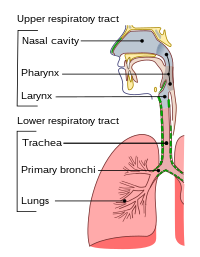
Photo from wikipedia
OBJECTIVE Phaeohyphomycosis is an infection caused by pigmented fungi, which can be life-threatening in immunocompromised hosts and in disseminated disease. In adults with disseminated disease mortality is as high as… Click to show full abstract
OBJECTIVE Phaeohyphomycosis is an infection caused by pigmented fungi, which can be life-threatening in immunocompromised hosts and in disseminated disease. In adults with disseminated disease mortality is as high as 79%. Data in children is derived from case reports and series. We conducted this study to review the characteristics of phaeohyphomycoses in children. METHODS We conducted this study following the PRISMA 2020 guideline for reporting systematic reviews. We performed a review of the reported cases of pediatric phaeohyphomycoses in core bibliographic databases published in the English and Spanish-language, between June 1977 and October 2021. We included all eligible cases in patients <18 years to determine the clinical characteristics, diagnosis, treatment, and outcomes. RESULTS 130 cases were reviewed. Mean age was 8 years. The most common underlying conditions and risk factors included hematologic malignancies (32.5%), neutropenia (26.9%), steroid therapy (24.6%), trauma or surgery (23.1%), and children that received a transplant (14.6%). The most common presentation was localized infection (61.5%); skin and soft tissue infections were the most prevalent (25.4%). Exserohilum spp (20.8%) and Exophiala spp (17.7%) were the most common organisms isolated. Antifungal therapy remains as the most frequent treatment (87%). Overall mortality rate was 22.3% (localized 13.7% vs disseminated 37.3%). CONCLUSION The findings of this review suggest that phaeohyphomycoses in children has a better outcome compared to adults. We report a lower mortality rate in children when compared with adults in disseminated infection (37.3% vs 79%) and CNS infection (50% vs 60-70%). However, there is a wide variation in mortality rates according to infection site, treatment, and underlying conditions. Prospective studies are needed.
Journal Title: Journal of the Pediatric Infectious Diseases Society
Year Published: 2022
Link to full text (if available)
Share on Social Media: Sign Up to like & get
recommendations!